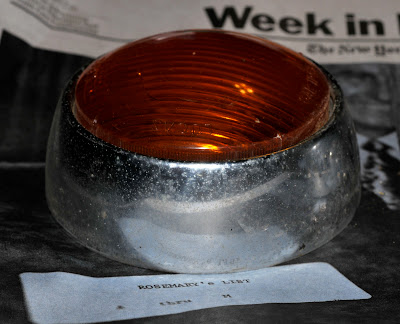The charcoal canister is part of the
evaporative control system. According to
Wikipedia, all cars sold in the US starting in 1971 (1970 in CA) needed to be equipped with a fuel evaporative control system. The idea is to prevent fuel evaporating from the gas tank entering the atmosphere; traditionally, expanding fuel vapor was released to the atmosphere. To prevent this the gas tank filler cap is sealed, thus forcing evaporative gases through a vent hose that lead to a canister containing activated charcoal. As the gas passes through the canister the charcoal sequesters the hydrocarbons and the "clean" air is then vented. When the car is running, air is sucked back through the charcoal and into the engine, burning off the gas vapor.
This Volvo canister (for a P1800) is open on the bottom to vent the filtered gas and to allow fresh air to enter the canister and passing back through the charcoal when the engine. From what I can tell (quick Google search) gasoline vapor is heavier than air, and therefor I don't understand why fuel vapor would not leak out the bottom of the canister? If the charcoal does hold on to the vapor well enough to prevent it leaking out the bottom, what makes the sequestered vapor "release" when the engine is pulling air back through the charcoal? Anyone? Inquiring minds want to know....
Regardless, the canister must have worked, or at least was better than just venting unfiltered gas - so the charcoal canister will get a makeover.
 |
Here is the charcoal canister with the hold down bracket removed; the less rusty band shows where the hold down bracket attached. The canister assembly sits between the front grille and radiator (I just learned that grills are for cooking and grilles are for cars). |
There were a bunch of holes rusted through the canister top, which, if the EVAP system is to work, clearly need to be filled. Given that the bottom also had extensive rust, I should probably have looked for a new or used replacement in better condition. Word on the interwebs is that the charcoal itself does not go bad, so I assume it does not need replacement (if it did, I wonder if aquarium filter charcoal would work?). I also hear that you don't really need the canister for the car to run correctly; but I do want to be somewhat eco friendly and it may also cut down on the gasoline smell in the garage. The canister itself is obscured by the radiator from the perspective of the engine bay, and by the front grille from the outside. Therefore we don't need perfection, just function. So I tried to plug the leaks, stop some of the rust, and make it look good enough that I will not be embarrassed to show pictures on this blog (all two or three of you - feel special).
A wire brush and sandpaper were used to remove rust scale, and a small amount of what I presume was a rubbery underbody coating. Before filling the holes with
JB Weld
, the top was coated with POR-15 "silver"paint, allowed to dry, and then scuffed up to provide key for the JB Weld adhere (not sure if that was necessary).
 |
The base of the canister. Note bits of the filter remaining on the left edge under the rusted steel lip. (Click for larger image) |
 |
Close up of the vents on the bottom; in the larger wholes you can see some kind of mesh that must hold the charcoal in place. |
 |
This is the best photo of the holes. The top has been coated in POR-15 Silver. The largest hole is South-East of the outlet on the top. |
 |
| The hardened JB Weld. I got it as flat as I could, but it's still mounded up. |
After the JB hardened, I used a Dremel tool to grind off the high spots and somewhat feather the edges of the epoxy. More grinding and sanding could have produced a flatter surface, but that did not seem necessary given the 'hidden' location of the canister.
After the grinding of the JB, the whole top and sides of the canister got two coats of POR-15 and a few light coats of primer.
 |
| Coated in primer, waiting for the final coat and maybe light sanding. |

 to even out the top surface and mask my poor smoothing and sanding of the Epoxy used to fill the holes. The putty sanded easily; it took a few coats to feather the surface up to the highs created by the epoxy. I hope it sticks to the primer!
to even out the top surface and mask my poor smoothing and sanding of the Epoxy used to fill the holes. The putty sanded easily; it took a few coats to feather the surface up to the highs created by the epoxy. I hope it sticks to the primer! 









































